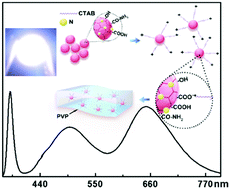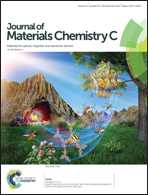Carbon dots with efficient solid-state photoluminescence towards white light-emitting diodes†
Abstract
Carbon dots (CDs) exhibit excellent ultraviolet (UV) absorption and tunable photoluminescence over the full visible light range, which endows CDs with huge potential to be designed as efficient full-color emitting phosphors for UV to white light conversion. However, the low quantum yield (QY) for white light emission and solid-state quenching dramatically limit their optoelectronic applications. We proposed an effective strategy for modulating the emitting states of colloidal CDs by introducing hexadecyltrimethyl ammonium bromide. Consequently, white light emission with tunable correlated color temperature from 8121 K to 3623 K was realized. Furthermore, we dispersed CDs in a PVP matrix for solid-state films, where the solid-state quenching was effectively avoided. A white light-emitting QY of 38.7% was thus achieved through the inhibition of non-radiative electron–hole recombination as well as the cooperation between the intrinsic state of the carbogenic cores and the surface-related state of the organic ligands. The white light emitting QY is much higher than that of other reported CDs (ca. 15% in the soluble state and not reported in the solid-state) and is comparable to that of the nanophosphors with the highest UV pumped single-component white light emissions reported in the literature.



 Please wait while we load your content...
Please wait while we load your content...